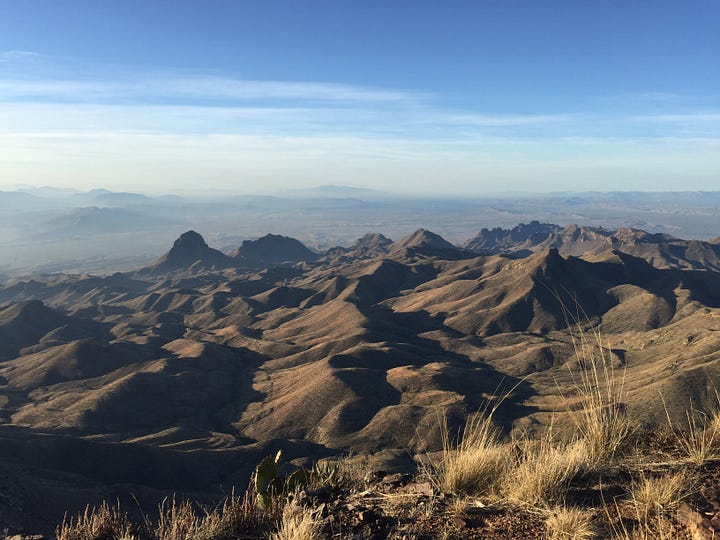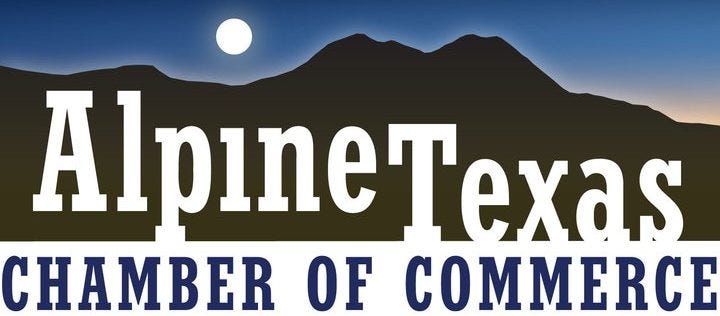How an Alpine Chamber of Commerce Could be Funded Through Partnership
An opportunity for partnership between the City of Alpine and Brewster County to further economic development.
Alpine used to have a Chamber of Commerce which was funded through city hotel occupancy tax (HOT) monies. In 2017, the Chamber’s funding from the city was transferred to the Visitor Center after the executive director was charged with theft. Since then, the Chamber has been mostly inactive and has struggled to retain board members. Organizations such as the Alpine Business Alliance have filled gaps in the business community, but don’t receive government funds as they’re not under their oversight.
However, a Chamber can provide value to the community. Currently there are 30 or more commercial buildings in the downtown and surrounding area that are vacant. Local entrepreneurs and businesses need to feel supported and have confidence they can succeed here. A Chamber of Commerce can be a hub of the business community, linking developers, investors, and ideas through conversation and relationships.
But How Could It Be Funded?
The city is earmarking over $100,000 towards economic development in this year’s budget. The money will go towards hiring an Economic Development Manager and ideas such as downtown facade improvements and small business grants; similar to what Pecos is doing with their economic development corporation. These funds and city HOT funds will not go towards a Chamber of Commerce, as the city uses it’s hotel occupancy tax monies to fund the Visitor Center - which does a great job.
Brewster County however, currently funds two Chamber of Commerce organizations; one in Marathon and one in Terlingua. Each was funded at $35,000 annually last year, but raised to $45,000 this year. The county has seen considerable increases in their HOT revenues over the last 10 years, as Big Bend National Park received national media attention. These hotel occupancy taxes come with restrictions though, which make them more difficult to spend. They must be spent on one of nine categories.
Note: I’ve verified with Justin Bragiel of the Texas Hotel and Lodging Association that Visit Big Bend, the HOT branch of the county, could legally fund an Alpine Chamber of Commerce. This would require approval from their board of directors.


So how much does Brewster County currently bring in for hotel occupancy tax revenue? Though the Texas Comptroller removed their data tool to view HOT monies collected by state agencies, I believe over the last 10 years it has increased from 1 to 2 million dollars annually. The city of Alpine brings in approximately $750,000. Unfortunately the county can’t legally spend this money on infrastructure to help with issues tourism can bring, per the requirements on HOT spending listed above.
So… Why Should the County Help the City?
Hotel occupancy tax monies are only part of the revenues the county and city receive. Sales tax is another revenue stream for both. Alpine is the economic driver of sales tax in our area. In their most recent budget, the county estimates receipt of around 1 million in sales taxes. The city of Alpine estimates around 2 million.
Before moving on an explanation on sales tax is needed. The state of Texas caps sales tax at 8.25%. Of this amount, 6.25% goes to the great state of Texas. This leaves local government with the ability to tax up to 2% more - capped at the legally allowed 8.25%. Unsurprisingly, the city and county use the entire 2% allowed, with 1.5% going to the city and 0.5% going to the county. For simplicity, if you bought $100 dollars of goods in Alpine, you would pay $8.25 in total sales tax - with $6.25 going to the state, $1.50 going to the city, and $0.50 going to the county.
Because we know Alpine’s sales tax rate and total sales tax revenue, we can use math to figure out the total amount of sales within the Alpine city limits. The formula is 0.015 * x = $2,000,000; with x being the total amount of sales within the city of Alpine. Solving, we find ‘x’ = 133 million; in other words the City of Alpine receives 1.5% sales tax on 133 million dollars of total sales within the city limits, generating 2 million in sales tax annually.
Formula Explanation: 0.015 (Alpine’s sales tax rate) * x (total sales within the city limits) = $2,000,000 (Alpine’s sales tax revenue)
What about the county? Since we know there are 133 million dollars of sales within the Alpine city limits, we can use the same number to derive how much of the county’s sales tax is generated within the city limits - in other words 0.005 * 133,000,000 = x. Solving for ‘x’, we find that around $665,000 of the county’s budgeted 1 million in sales tax is generated within the city limits - or 67% of their total sales tax revenue. This makes sense as people that live within Alpine and the county both shop in the city.
Formula Explanation: 0.005 (Brewster County’s sales tax rate) * $133,000,000 (total sales within the city limits) = x (County sales tax revenue generated within Alpine’s city limits)
It should be mentioned that the city and county already partner in other areas. The Emergency Services Board and landfill are a few examples. The Emergency Services Board is currently co-funded by both entities committing $50,000 each. This makes sense as it provides services to both city and county residents.
What Does the City Bring to the Partnership?
As mentioned above the city is earmarking over $100,000 towards economic development this year. The new Economic Development Manager position should work closely with the Chamber of Commerce. This position will be directed to bring in outside investment and align it with business and resident needs.
More than anything the new economic manager needs to be a people person. They need to form relationships with local businesses, ask them what they need, and let them know about economic grants or funds the city offers.
A Partnership to Get Things Done
I’d love to see the county fund an Alpine Chamber of Commerce the way they fund the Marathon and Terlingua organizations - at $45,000 annually. If funding a Chamber increased economic activity by just 1% above our current 133 million in gross sales, sales tax revenue would increase by $19,950 for the city and $6,650 for the county.
Every Texas Municipal League event I’ve attended has stressed the importance of partnerships between governing entities. Working together fills in gaps where one group has more resources. I feel the county is blessed with hotel occupancy tax monies so this could be a great way to help Alpine focus on economic development. A Chamber of Commerce with great vision can drive more sales tax revenue to both entities and offer residents in our area more business options and services.





